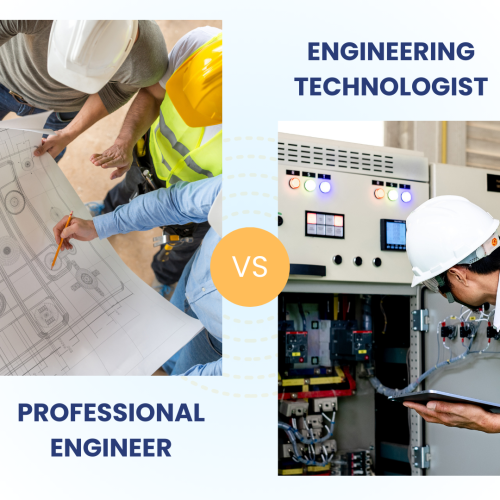ENGINEERING TECHNOLOGIST
VS
PROFESSIONAL ENGINEER

Which Engineering Category Fits Your CDR Application? (Part 1)
When putting together your Competency Demonstration Report (CDR) for Engineers Australia (EA), you’ll need to pick one of four main career tracks: Professional Engineer, Engineering Technologist, Engineering Manager, or Engineering Associate. Each one requires a solid technical degree, like a Bachelor of Engineering or something equivalent under the Australian Qualifications Framework (AQF). But what makes them different? It mostly comes down to the focus of your studies and where you got your degree.
In this guide, we’ll break down the key differences between these categories to help you figure out where your skills and experience fit best:
The Professional Engineer category is for highly skilled engineers who take full responsibility for engineering projects and programs. The minimum requirement is a 4-year Bachelor of Engineering degree (per AQF standards) or an equivalent qualification, typically from institutions listed in Section 1 of EA’s accredited programs.
Key Roles and Responsibilities:
- System Management: Ensuring that materials, components, subsystems, and technologies work seamlessly together to create sustainable and efficient systems.
- Complex Problem-Solving: Integrating knowledge from multiple sources to develop solutions that balance technical and non-technical factors, while managing risks and ensuring sustainability.
- Strategic Guidance: Advising and communicating technological solutions to society, businesses, or governments, providing clear insights into costs, risks, and limitations.
Example: If you hold a Bachelor’s degree in Civil Engineering from a Section 1 EA-accredited institution and your work experience involves construction or project management, your CDR would likely fall under the Civil Engineer category.
The Engineering Technologist category is one of the most popular choices for CDR applicants with EA. It suits engineers from diverse fields such as Mechanical, Chemical, Electrical, Electronics, and other engineering disciplines.
The typical qualification requirement is a Bachelor’s degree in Engineering or equivalent from institutions listed in Section 2 of EA’s standards. While this category doesn’t demand the same comprehensive system-level perspective as Professional Engineer, it still requires high technical expertise and the ability to apply technology across varied contexts.
Key Roles and Responsibilities:
- Technology Application and Management: Engineering Technologists specialize in applying, adapting, or managing existing and emerging technologies in diverse settings. They are often experts in a specific technological domain, with deep knowledge of the latest applications and advancements in their field.
- Bridging Theory and Practice: Their work requires a strong understanding of scientific and engineering principles, combined with analytical skills to keep pace with cutting-edge technological advancements and apply them practically.
Why Is Engineering Technologist So Popular?
This category is favored for its flexibility and accessibility. If you graduated from a Section 2 institution per EA’s standards, this is often the most suitable pathway. In some cases, engineers who qualify for the Professional Engineer category also opt to include Engineering Technologist in their application to increase their chances of receiving a skilled visa invitation. This strategy can boost points in the Expression of Interest (EOI), opening more opportunities on the journey to migrating to Australia.
Need help with your skill assessment, contact us directly here. We will be in touch shortly for a discussion.
